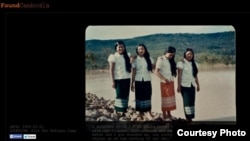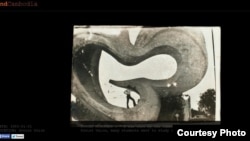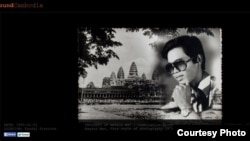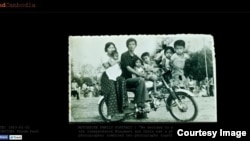[Editor’s note: Photographer Charles Fox has spent years collecting pictures of Cambodian families. He has assembled these images on a website called “Found Cambodia,” which displays 150 of these images—showing a Cambodia before and after the Khmer Rouge. Alongside them are the stories of the families who took the photographs, in what he hopes will become a living archive, to preserve photographs that might otherwise disappear. Fox recently spoke to VOA Khmer in Phnom Penh.]
Would you mind telling us a little bit about your project?
I first came to Cambodia in 2006. At that time I was doing work for newspapers, a lot for the Cambodia Daily, regional publications. So I have a reasonable history of working in Cambodia, I think. You spend a length of time in the country, you cover news and events, but I became very interested in the day to day, what I didn’t see, the stories that I didn’t hear.
In 2008 I returned to UK, and I met a Cambodian artist, a guy called Yanny, and he started showing me his family photographs. And we would talk about the photography and we talked about the people in the pictures, and he would tell me about their history. And I thought this is a really interesting way of representing the way that Cambodian society has changed and how it has grown through difficult periods, but not relying on specific historical events, but just relying on the narrative of the people, you know, their dreams, their hopes, their aspirations.
So I made a promise to Yanny that if and when I returned to work in Cambodia, that I would start this project. So I did, I returned in 2012, and started the project. So what I have been doing is meeting with people and looking through their family portraits, looking at their family history, finding interesting pictures, finding interesting stories, and presenting them to tell a little bit about the Cambodian experience, how people have lived, how they dealt with hardship. So that’s essentially what the project started out as.
It started as a blog, so I just tried to post a picture every day. It was a strange thing, because I wasn’t expecting that many people to be excited or interested by it. I started this project because I was fascinated by it. But it quickly developed a following; people became interested, so I kept working on it. And then about three months ago, I wanted to change direction of the project, I wanted to make it more of an archive, the people could actually visit, give it a permanent home, hence why I made the “Found Cambodia” website.
The website was developed in Cambodia, and it took three months to do, but it was a specific plan. The plan would be that these images would be presented in such a fashion that people could search the images, so you could type in keywords, key phrases, and get search results. And I just felt it was more of respectful way of presenting the work rather than just on a blog, to give it a dedicated home. And the project continues to go from there. So at the moment like you said there are 150 images on there. But I’ve got stacks more to put on; it’s a process of uploading them and also meeting people and interviewing them about the project.
Up to now, how many people have been involved in your project?
I must have spoke to so far 50 to 60 individuals and families, in the UK, in Cambodia, and more recently America. Some of these conversations have happened by chance, one of the things I really enjoy about Cambodia is more often, although it’s becoming less and less, but a business will also be the home as well. So you walk into a store, and there will be family photographs on the wall. So I go to buy something I notice these framed pictures on the wall, start a conversation, and I involve people in the project that way. Other times, I worked with a translator to look at specific areas of interest. Like for a while, I was really interested in wedding photography. The way that wedding photographs are produced in Cambodia is fantastic. This process of taking the picture and then changing the background, multiple styles, costumes, I really wanted to explore that as a theme, so I worked specifically looking for those pictures.
More recently, I’ve had people approach me about the project. So a Cambodian American approached me about 3 weeks ago, and he has given me 30 to 40 images, which he’s asked me to include in the project. So that’s been a process of Skype interviews, we are on our second Skype interview, the first one was 3 hours, the last one was two hours long. And then my Cambodian friends in the U.K. have supplied images for the project as well. It is interesting the way that people get involved. You know as a journalist, you’ll often be on deadline, you have to get a story and present it in a very short space of time where this project is not the same thing. You know, I am not chasing really anything. People get involved, people are interested, people supply images, and it just happens very naturally, and grows very organically. And that’s part of the joy of this project. People who are involved have chosen to be involved. People who don’t want to be involved, they don’t have to be involved. It’s different from, you know, as a photographer, trying to document something in a short space of time to creating a project such as “Found Cambodia" that has such a strong narrative. The relationships are completely different, you know, it’s an exchange of information, and I enjoy that about the project.
Regarding the narration of the people’s stories and lives and the impact through the hardships in Cambodia, particularly civil war, what did you see through their history and the images?
One of the things that has always drawn me about working in Cambodia, one of the things that I have always enjoyed about working in Cambodia is the resilience of the Cambodian people. That ability to adapt and overcome and face new challenges, and that’s been one of the things as a photographer that’s always drawn me to this country. And in terms of the project, what I was able to see first hand is the resilience of individuals. So I would see a lot of families who would go and study in Russia. Would go as students, do an exchange, would arrive in these foreign countries with very little language skills. Russia was a very cold country and they would adapt and overcome and assimilate into life there. I’d see families, I’d see people who worked for UNTAC as translators, translating for foreigners who come work in Cambodia. I’d see families coming through the early 1990s, experiencing their first time with travel. And how people went from nothing, absolutely nothing, to grow and develop their lives to the point where you could see visible change in their experience.
Do you have any photographs of families that show their history from before the Khmer Rouge and then the change?
When I first started the project, I was interested from pretty much from 1979, 1980, I suppose was the first time I got photographs. Up to the point when printed photographs would stop, film photography stopped, because these are the fragile pictures. And when I started to meet more people, these images from before the Khmer Rouge would appear. And I thought, well how can I not include these, I have to change the scope of the project to include these photographs.
So I’ll often see family portraits as a complete family pictures before the Khmer Rouge, and then after the Khmer Rouge, a family portraits as a complete family picture before the Khmer Rouge, and then after the Khmer Rouge a similar portrait but with family members missing. And that as a photographer, I find that really powerful, you know, the before and after comparison, family members removed.
I have this one example where a lady constructed a family portrait. She took passport photographs from before the Khmer Rouge and built a picture with the individuals, put four pictures down, and then told me the history of each of these people. She said this person survived, this person survived, this person died at the hands of the Khmer Rouge. So these pictures from before the Khmer Rouge, these family photographs, are incredibly powerful. Because often the story that goes with the image, is a story of hardship, loss and trauma. And they are very hard images to deal with. But it is very interesting again when we talk about this resilience, where people present these images and bring them forward. This opened us to share these images, so I’ve been really touched by that.
This year is the 40th anniversary of the fall of Phnom Penh to the Khmer Rouge. Life here has changed through that, and hardship and loss. How have people’s families changed from before Khmer Rouge then after Khmer Rouge, and now?
When you look at most of the images I have right now from before the Khmer Rouge, it is obvious when you look at the images that people had no real sense of tragedy that was about to happen. There’s still innocence in those images. Then you look at images directly after the Khmer Rouge, and you know, you get a sense of relief that those hard times are over, but also still there’s a real sense of coming together. So, I see a lot of family group portraits very early on. I see people trying to create bonds, trying to create relationships.
So one image that always stuck with me is a photograph of two ladies dressed in exactly the same clothes. The picture struck me. Same color, the style, exactly the same. And when I asked the lady why? She said that they are not sisters, we’re friends, but we felt a bond in our relationship so strong that we felt like sisters but we weren’t from the same family. So by dressing in a similar way we felt closer together, we felt like family. So I get a real sense that in the early photographs, there’s a real effort to recreate bonds and relationships which would have been decimated by the Khmer Rouge. And that is really interesting early trend in the photographs. Probably the most touching part of the project for me.
So how is it now? How are their lives, how is their history, changed from the early 1980s up to now?
I have been interested the way that people started to rebuild their lives. I’m British, and I look at my family photographs and my family history. And for me there is nothing remarkable about that. You know, my country has had stability for a long period and I’m very grateful for that. But when I look at Cambodian photographs. those early pictures, there is a real sense of trying to improve the situation. These things are mark by photographs. So the acquisition of a new motorbike, for example, is documented in photography. I have photographs of couple, photographing themselves with their new motorbike because they wanted to mark that this is as an important part, as a development in their own lives. I see pictures of when people going on holiday the first time.
People really try to document the improvement in their lives in photography. And it’s more poignant in Cambodia because of the recent history, you know, and the history of the Khmer Rouge. People will document these changes, acquisition of goods, moving into new home, but they’ll also document their aspirations. I came across photographs of a lady who had a portrait taken, and then the background was changed. In the background there was a house, with a swimming pool and a car. And when I asked her about this, why she chose that background, she said that wasn’t about her aspiration, it was the aspiration she had for her children, that they would be able to live in comfort. So there is the documentation of it, but there is also the aspiration of being able to have a stable and secure life. And I really see that in the trends in Cambodian family photography.
The thing is that the project like this, as I said, I can’t chase the story. The story has to happen. But the more images I see, the more of the story, it’s a like a jigsaw, you can place this picture in. And that’s why the search elements of the website become so important because in the first instance, I did it so I can make sense of these images. So I can search for certain things and then be able to present them as groups of photographs to show trends. So the more images I see, the more of a narrative I construct. But early on, and it still feels early to me because you can’t answer these questions in 18 months, two years, just not possible. But I see a resilience, I see hope, I see aspiration. But I also see elements of joy, particularly in the family. These group portraits are really strong. And the treatments of these images are really strong.
You said earlier that you want to develop the site into an archive. So people can upload and put the photos themselves?
Absolutely. You know with the project like this I had the idea as a blog, and then it evolved. The archive was something that was always important to me, but I had to work to that stage. Now it’s in a format where its more of an online archive. I wanted people out there to interact, to search the website, to share images on social media, to create discussion around the project. But what happened a few weeks ago was I received an email from a Cambodian man in America who donated images to the website. Now I’d always hoped that this would happen, but the reality of it happening was far more exciting than what I thought about it.
The Cambodian-American stories are very interesting. The case of the man that I spoke to, he was from Battambang. He lost his father and a lot of his relatives. But his mother, and his brothers and sisters, he's one of seven, survived. And they did two things during Khmer Rouge. They buried jewel and gold and they buried photograph. And these photographs from before Khmer Rouge survived. These two things when they went to the border they took with them.
The gold to help them get to the border and help them set a new life, and their photograph, their history, that was the two things they saved. And for me that’s incredibly powerful. And I know there is more images like that out there. So, when he donated those images to the project, we started to talk and the project is much richer from that involvement. And I think people can contact me, approach me through the website, and if they want to share their images, and share their stories, they can.
My biggest fear is, with printed photography, more often than not, Cambodia is not a very forgiving climate for printed photography. It’s hot, there’s a lot of humidity. And the actual film doesn’t survive. Very well I remember, going into the office of the Cambodia Daily, when photographers used to keep all the films, negative in the office because there’s air-conditioning, it was the only safe place to keep them. And you know that I never had that experience coming from England, it’s a cold country, we didn’t have to care for negatives in the same way. So what’s happening is this recent history of Cambodia that has been documented by their own photography, I’m fearful of the loss of this.
The damages, you can see on the website itself, damaged images. The pictures that were donated from the Cambodian-American man, when they crossed the border into Thailand, there was a heavy monsoon, and his pictures survived all the way through the Khmer Rouge when they were buried into the ground. And they got to Thailand, and they were only under a small tent, water got into the bag and damage their family history. Now they looked after them, they’ve scanned them, they’ve saved them. How many more images are in that condition? And to include those into project for me would be, I think it is really important. People’s own personal history is a very important part of the development of a country. You know we can be the headlines and the news, and that is very important. But personal experiences through images are a whole different side of documentation about the life and growth of a country. And as much as I can, I would like to preserve this. So if people feel they want to contribute images and their stories to the project then for me that takes the project to the next level, it helps it grow.










